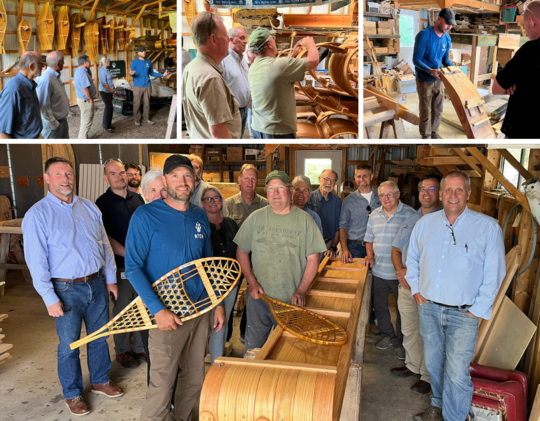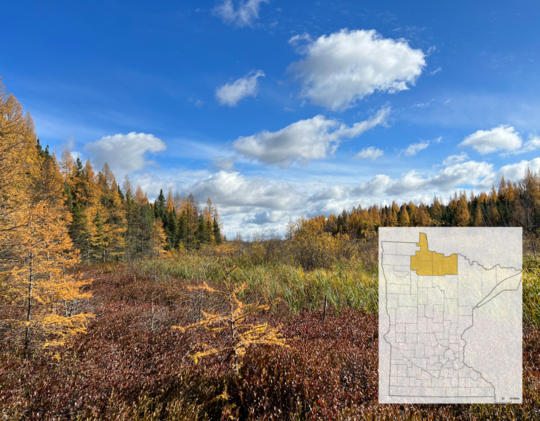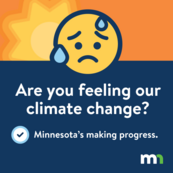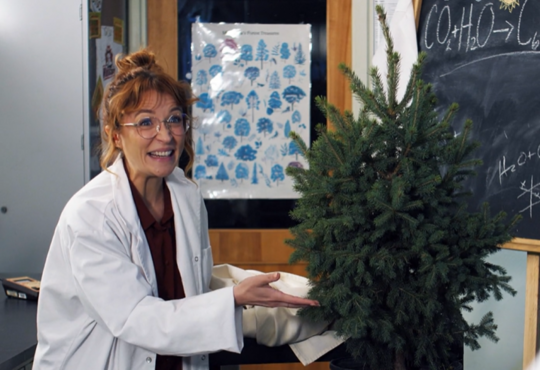|
August 20, 2024

MFRC members tour Northern Toboggan.
A stretch of farmland just east of Warroad, Minnesota, is home base for Northern Toboggan. The family-owned business produces handmade wooden toboggans, sleds, snowshoes, and more, from ash and hardy red oak.
Minnesota Forest Resources Council (MFRC) members recently visited the Northern Toboggan workshop for a firsthand look at the craftsmanship that goes into the Harren family’s Minnesota-made wood products. Council members also toured the Marvin windows and doors manufacturing plant and the Advanced Resource Center for Innovation and Education, connecting with community members to discuss how the forestry sector contributes to the economic, social, and environmental aspects of living and working in Roseau, Lake of the Woods, Beltrami, and Koochiching counties.
The MFRC works to support a strong forest products industry that benefits the maintenance of healthy forest lands and Minnesota’s economy. Meet your council members and see the stakeholders whom they represent, including the forest products industry and secondary wood products manufacturers.

Photo courtesy of Kirby Readman.
The Minnesota Forest Resources Council Northern Regional Forest Resource Committee invites participation in an Aug. 20 through Sept. 20 public comment period to gather feedback on the updated Northern Landscape Plan for sustainable forest resource management. The plan covers Koochiching, Lake of the Woods, and the northern half of Beltrami County, providing:
- A framework for collaboration on forestry with consideration of economic, social, and ecological needs of the region.
- A voluntary guide for land managers, natural resource practitioners, and community development organizations to follow and coordinate on shared goals.
Elements of the MFRC’s regional landscape plans are often incorporated into county, state, and federal land management planning efforts. Learn more about the planning process, review the current draft, and share your feedback via the public comment process.
Save the Date: Join us for an open house for the Northern Region Landscape Plan on Aug. 26, 10 a.m. – 12 p.m. at the Cobblestone Hotel, 1 Memorial Dr., International Falls, Minn., or attend online. Audio participation is welcome by calling 877-309-2073, access code 307-668-869. This gathering is an opportunity to preview the updated Northern Landscape Plan, connect with contributors, learn about region-specific sustainable forest management goals, and share your input.

Photo courtesy of Anna Stockstad.
The MFRC has finalized updates to the Voluntary Site-Level Forest Management Guidelines (FMGs) and will be releasing a revised version of the comprehensive resource that incorporates:
- Additional direction on effective practices related to invasive terrestrial plant species.
- Language to address linkages between the guidelines and mitigation of climate change risks.
- Adjustments to support consistent interpretation of the guidelines.
- Format enhancements to conform with the Americans with Disabilities Act, Web Content Accessibility Guidelines, and Section 508 accessibility compliance.
Updates were informed by an extensive process that accounts for current science and practical guidelines, including monitoring program results, peer review and feedback from diverse stakeholders, and a public comment process.
“Minnesota is fortunate to have statewide voluntary guidelines for forest management and timber harvesting that landowners, loggers, and natural resource professionals implement at such a high rate on the ground,” said Kory Cease, MFRC Site-Level Committee chair and Itasca County land commissioner. “We are excited to be releasing FMG updates that will continue supporting them in their efforts to sustainably manage Minnesota’s forests.”
In addition to adopting recommended changes, the MFRC is focused on renewed training to support consistent application of the FMGs. As part of this effort, the University of Minnesota Forestry Extension recently piloted in-person workshops on the guidelines, in collaboration with the MFRC, the Sustainable Forests Education Cooperative, and the Minnesota Logger Education Program.
“The workshop format, standardized curriculum, including a podcast series and lessons plans for each FMG module, represent a successful start of a new FMG training program for Minnesota,” said Anna Stockstad, University of Minnesota Extension educator and principal investigator for the pilot workshops.
Planning is underway for additional FMG trainings and workshops in 2025. Stay tuned to this newsletter to be notified when the updated version of the FMGs is available online and for download, and subscribe to the FMGs refresher podcast.

Kylee Berger traces her interest in forestry back to childhood. Rarely indoors, she formed a friendship with the couple next door who taught her about the woods and wildlife, inviting her along as they cared for their land, bird watched, and harvested from trees. Berger later jumped at the opportunity to take a forestry class offered during high school and continued her studies in college, graduating from the University of Minnesota with a degree in forest and natural resource management. Today, she is a private lands forester with the Department of Natural Resources and continues her service to forest stakeholders as chair of the West Central Landscape Committee.
One year into the role, Berger is encouraged by a growing interest she sees in the committee and the new connections it is building.
“Getting in the same room and thinking about the same things gives us an opportunity to work toward shared goals in our own ways,” she said.
Berger sees the committee as an important space for building understanding of the area’s natural resources, the people and organizations involved in its management, and ways to work together to better the landscape. As an example, with a large contingency of private land in the West Central Region, committee members have invested considerable effort to connect private landowners with tree planning resources. They share information on agency programs and methods to implement this important effort to mitigate climate change and help meet the Minnesota Climate Action Framework’s goals. The committee also continues to build and broaden relationships with diverse stakeholders, such as agricultural and military agency staff who also work with private landowners to bring more perspectives to regionally specific issues.
“There’s a lot of great discussion and a lot of great connections made at the meetings” Berger said. “I think that’s why people keep coming back – it’s obviously worth their time.”
This feature is part of an ongoing newsletter series introducing chairs of the MFRC’s six regional landscape committees. The MFRC Landscape Program is voluntary, grassroots, and incorporates the broad variety of interests and perspectives of forest management and forest resource issues. Photo courtesy of Kylee Berger.
|

State leaders have released a report sharing progress toward Minnesota’s Climate Action Framework since its September 2022 launch. While climate change is disrupting life in Minnesota more than ever before, notable progress is being made on Climate Action Framework goals.
The MFRC is focused on strengthening the capacity of the forestry sector to help Minnesota prepare for climate change. That’s why the Council continues investing in strategies to help achieve goals of the Minnesota Climate Action Framework. Our recent efforts include:
- Advancing research with the University of Minnesota to create a forest carbon baseline and life cycle assessment that estimates carbon sequestration, storage, and emission outcomes of forest management strategies and forest products. This research seeks to help public and private forest landowners, foresters, forest product industries, and policymakers better understand and compare forest management activities and associated outcomes for mitigating climate pollution.
- Updating statewide forest management and logging guidelines to incorporate climate change and invasive species considerations.
- Supporting a Clean Transportation Standard for renewable diesel and sustainable aviation fuel that includes woody biomass as a low carbon biofuel option. Since 2018, the EPA has designated woody biomass as a “carbon-neutral” source of bioenergy. Biomass markets support climate adaptive management of forests impacted by increased tree mortality from weather, insects, and disease.
Minnesota state government will release an updated Climate Action Framework in 2025 and engage with residents over the next year to understand what climate actions should be included. Stay up to date on the process to develop updates to the Climate Action Framework and learn how to provide feedback here.
|

"Trees Are Carbon" image courtesty of MFI.
Minnesota Forest Industries (MFI) Trees Are Carbon (Video)
This Silver Telly award-winning public service announcement produced by the Minnesota Forest Industries and Hubbard Broadcasting Inc. incorporates humor and science to educate on the carbon sequestration and storage abilities of trees and wood products.
Sustainable Forestry – A Management Guide for Private Forest Landowners, Fifth Edition
MFRC is a member of the Minnesota Sustainable Forestry Initiative Implementation Committee that published this guide for private forest landowners. It is chock-full of helpful guidance, information, and resources to support private forest landowners with sustainably managing their forest to achieve their individual goals.
The Impact of Active Aspen Management on Ruffed Grouse Habitat in Lake States (Video)
Take a virtual trip to the Chippewa National Forest to learn how the management of Aspen supports ruffed grouse habitat and populations. This video was produced by We the Forest, in partnership with the Federal Forest Resource Coalition, and features MFRC member Scott Johnson, who shares his knowledge as state conservation coordinator for the Ruffed Grouse Society and American Woodcock Society. Johnson is appointed to the MFRC as a representative of games species management organizations.
|